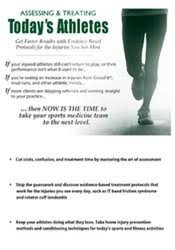Finally, explore the unique biomechanical demands of common sports and fitness activities and take home injury prevention methods and conditioning techniques that keep your clients doing what they love, whether they’re swinging golf clubs or kettlebells.
Darrell Locket – Assessing & Treating Today’s Athletes
Why Some Injured Athletes Never Return to Play—and What You Can Do About It
Whether they’re wrecking themselves in CrossFit® or football, record numbers of weekend warriors are cropping up with the sports injuries of professional athletes. That means business is booming for rehab professionals like you. However, with more athletes skipping physicians than ever before, you’ve got to be confident in your assessment skills if you hope to treat symptoms at their source. If your caseload has stalled during this busy time with patients who aren’t making much progress, now’s the time to reevaluate your evaluations.
This hands-on program will take your sports medicine team to the next level, equipping you with evidence-based, multidisciplinary protocols for the athletic injuries you see most. From IT bands to impinged rotator cuffs, this course provides efficient clinical pathways for each member of your team, eliminating the guesswork from assessment, evaluation, treatment, and rehabilitation. With plenty of practice throughout the day, you’ll quickly grasp the “why,” “what,” and “how” of common conditions like acute/chronic inflammation, microtrauma, neuromuscular imbalances, and joint instability. The effective interventions you’ll try out in class will feel like second nature by the time you return to work.
Finally, explore the unique biomechanical demands of common sports and fitness activities and take home injury prevention methods and conditioning techniques that keep your clients doing what they love, whether they’re swinging golf clubs or kettlebells.
Analyze the anatomy, mechanics, and pathology of common sports injuries, reviewing differences in injuries seen in youth, adults, and other groups
Compare assessment techniques for connective tissue injuries such as muscle, tendon, and ligament
Identify orthopedic stress test techniques and methodologies for the upper and lower extremity
Review evaluation techniques for abnormal biomechanics of gait and abnormal physiology of the kinetic chain
Design preventive and reconditioning regimens that reduce the likelihood of injury for upper and lower extremity
Integrate multidisciplinary clinical protocols for common sports injuries, covering assessment, evaluation, treatment, and rehabilitation
Sports Medicine Team Practitioner Approach to Treatment of Sports Injuries
Treatment of the injury: Non-operative and operative (types of surgery)
Healing phases and rehabilitation
Lab: Comprehensive sports injury physical examination
Lab: Gait, posture, and functional kinetic chain assessment
LAB: Physical Examination of the Ankle & Lower Leg
Preventive measures, mechanics of injuries, inspection of gait, range of motion, manual muscle testing, and special stress tests
Pes anserinus bursitis or tendonitis
Shin splint or medial tibial stress syndrome
Posterior tibial tendon dysfunction
Achilles tear, strain, bursitis, tendonitis, or tenosynovitis
Gastrocnemius and soleus strain
Retrocalcaneal bursitis or Sever’s syndrome
Lateral and medial ankle sprain
Syndesmotic injuries (high ankle sprain)
Tarsal tunnel
Interdigital (Morton’s) neuroma
Plantar fasciitis
Peroneal tendon subluxation
Jones fracture
Stress fracture
Avulsion fractures
LAB: Physical Examination of the Knee, Hip, & Thigh
Preventive measures, inspection of gait, squats, lunges, range of motion, mechanics of injuries, palpation, and special stress tests
Ligament injuries
Anterior and posterior cruciate
Medial and lateral collateral
Cartilage injuries
Meniscal tears
Articular
Degenerative joint disease
Patellafemoral injuries
Chondromalacia
Malalignment and instability
Tendonitis or Osgood-Schlatter
Degenerative joint disease
Muscle injuries
Gluteus maximus weakness
Gluteus medius and minimus weakness
Tensor fascia lata weakness
Quadriceps femoris and hamstring strain/tendonitis/ruptures
Hip injuries
Hip impingement
Trochanteric bursitis
Adductor strain
Iliotibial band friction syndrome
Would you like to receive Darrell Locket – Assessing & Treating Today’s Athletes ?
LAB: Physical Examination of the Shoulder & Arm Injuries
Preventive measures, inspection posture, functional movement, mechanics of injuries, range of motion, palpation, and special stress tests
Glenohumeral instability, anterior or posterior joint
Rotator cuff strain, impingement or tendonitis
Pectoralis strain
Acromioclavicular joint sprain
Brachial plexus (burner/stinger)
SLAP lesion
Bicipital tenosynovitis/subluxation
Triceps and biceps strain
Bursitis of elbow
Lateral and medial epicondylitis of the elbow
LAB: Physical Examination of the Back Injuries
Preventive measures, inspection gait, posture, functional kinetic chain assessment, mechanics of injuries, range of motion, palpation, and special stress tests
Piriformis syndrome and sciatica
Erector spinae muscle strain
Sacroiliac sprain
Acute and chronic low back pain
Lumbar spinal stenosis
LAB: Physical Examination of the Wrist, & Hand Anatomy
Preventive measures, inspection posture, mechanics of injuries, range of motion, palpation, and special stress tests
Trifibrocartilage (TFC)
DeQuervain’s
Hand and fingers fracture/other conditions
Gamekeeper’s thumb








